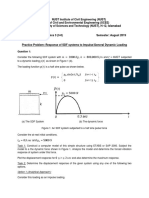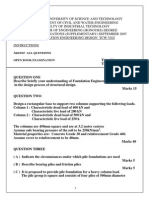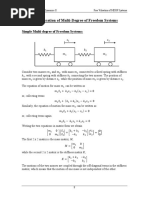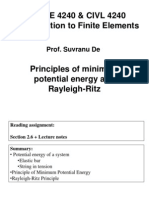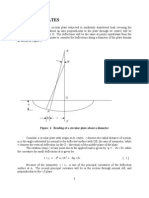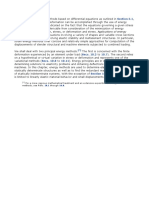Minimum Potential Energy
Minimum Potential Energy
Uploaded by
Bright MuzaCopyright:
Available Formats
Minimum Potential Energy
Minimum Potential Energy
Uploaded by
Bright MuzaCopyright
Available Formats
Share this document
Did you find this document useful?
Is this content inappropriate?
Copyright:
Available Formats
Minimum Potential Energy
Minimum Potential Energy
Uploaded by
Bright MuzaCopyright:
Available Formats
Hutton: Fundamentals of
Finite Element Analysis
2. Stiffness Matrices,
Spring and Bar Elements
Text The McGrawHill
Companies, 2004
42 CHAPTER 2 Stiffness Matrices, Spring and Bar Elements
Again invoking the strength of materials results, the angle of twist at the end of the mem-
ber is known to be
=
TL
JG
so the strain energy can be written as
U
e
=
1
2
L
JG
_
JG
L
_
2
=
JG
2L
2
Per Castanglianos rst theorem,
U
e
= T =
JG
L
which is exactly the relation shown by strength of materials theory. The reader may think
that we used circular reasoning in this example, since we utilized many previously known
results. However, the formulation of strain energy must be based on known stress and
strain relationships, and the application of Castiglianos theorem is, indeed, a different
concept.
For linearly elastic systems, formulation of the strain energy function in
terms of displacements is relatively straightforward. As stated previously, the
strain energy for an elastic system is a quadratic function of displacements. The
quadratic nature is simplistically explained by the facts that, in elastic deforma-
tion, stress is proportional to force (or moment or torque), stress is proportional
to strain, and strain is proportional to displacement (or rotation). And, since the
elastic strain energy is equal to the mechanical work expended, a quadratic func-
tion results. Therefore, application of Castiglianos rst theorem results in linear
algebraic equations that relate displacements to applied forces. This statement
follows from the fact that a derivative of a quadratic term is linear. The coef-
cients of the displacements in the resulting equations are the components of the
stiffness matrix of the system for which the strain energy function is written.
Such an energy-based approach is the simplest, most-straightforward method for
establishing the stiffness matrix of many structural nite elements.
(a) Apply Castiglianos rst theorem to the system of four spring elements depicted in
Figure 2.10 to obtain the system stiffness matrix. The vertical members at nodes 2
and 3 are to be considered rigid.
(b) Solve for the displacements and the reaction force at node 1 if
k
1
= 4 N/mm k
2
= 6 N/mm k
3
= 3 N/mm
F
2
= 30 N F
3
= 0 F
4
= 50 N
EXAMPLE 2.6
Hutton: Fundamentals of
Finite Element Analysis
2. Stiffness Matrices,
Spring and Bar Elements
Text The McGrawHill
Companies, 2004
2.4 Strain Energy, Castiglianos First Theorem 43
F
2
F
4
k
2
k
2
k
1
k
3
1
2 3
4
Figure 2.10 Example 2.6: Four spring elements.
I Solution
(a) The total strain energy of the system of four springs is expressed in terms of the
nodal displacements and spring constants as
U
e
=
1
2
k
1
(U
2
U
1
)
2
+ 2
_
1
2
k
2
(U
3
U
2
)
2
_
+
1
2
k
3
(U
4
U
3
)
2
Applying Castiglianos theorem, using each nodal displacement in turn,
U
e
U
1
= F
1
= k
1
(U
2
U
1
)(1) = k
1
(U
1
U
2
)
U
e
U
2
= F
2
= k
1
(U
2
U
1
) + 2k
2
(U
3
U
2
)(1) = k
1
U
1
+ (k
1
+ 2k
2
)U
2
2k
2
U
3
U
e
U
3
= F
3
= 2k
2
(U
3
U
2
) + k
3
(U
4
U
3
)(1) = 2k
2
U
2
+ (2k
2
+ k
3
)U
3
k
3
U
4
U
e
U
4
= F
4
= k
3
(U
4
U
3
) = k
3
U
3
+ k
3
U
4
which can be written in matrix form as
_
_
_
_
k
1
k
1
0 0
k
1
k
1
+2k
2
2k
2
0
0 2k
2
2k
2
+k
3
k
3
0 0 k
3
k
3
_
_
_
_
U
1
U
2
U
3
U
4
_
_
=
_
_
F
1
F
2
F
3
F
4
_
_
and the system stiffness matrix is thus obtained via Castiglianos theorem.
(b) Substituting the specied numerical values, the system equations become
_
_
_
_
4 4 0 0
4 16 12 0
0 12 15 3
0 0 3 3
_
_
_
_
0
U
2
U
3
U
4
_
_
=
_
_
F
1
30
0
50
_
_
Eliminating the constraint equation, the active displacements are governed by
_
_
16 12 0
12 15 3
0 3 3
_
_
_
_
_
U
2
U
3
U
4
_
_
_
=
_
_
_
30
0
50
_
_
_
which we solve by manipulating the equations to convert the coefcient matrix (the
Hutton: Fundamentals of
Finite Element Analysis
2. Stiffness Matrices,
Spring and Bar Elements
Text The McGrawHill
Companies, 2004
44 CHAPTER 2 Stiffness Matrices, Spring and Bar Elements
stiffness matrix) to upper-triangular form; that is, all terms below the main
diagonal become zero.
Step 1. Multiply the rst equation (row) by 12, multiply the second equation (row) by
16, add the two and replace the second equation with the resulting equation
to obtain
_
_
16 12 0
0 96 48
0 3 3
_
_
_
_
_
U
2
U
3
U
4
_
_
_
=
_
_
_
30
360
50
_
_
_
Step 2. Multiply the third equation by 32, add it to the second equation, and replace
the third equation with the result. This gives the triangularized form desired:
_
_
16 12 0
0 96 48
0 0 48
_
_
_
_
_
U
2
U
3
U
4
_
_
_
=
_
_
_
30
360
1240
_
_
_
In this form, the equations can now be solved from the bottom to the top, and it will be
found that, at each step, there is only one unknown. In this case, the sequence is
U
4
=
1240
48
= 25.83 mm
U
3
=
1
96
[360 + 48(25.83)] = 9.17 mm
U
2
=
1
16
[30 + 12(9.17)] = 5.0 mm
The reaction force at node 1 is obtained from the constraint equation
F
1
= 4U
2
= 4(5.0) = 20 N
and we observe system equilibrium since the external forces sum to zero as required.
2.5 MINIMUM POTENTIAL ENERGY
The rst theorem of Castigliano is but a forerunner to the general principle of
minimum potential energy. There are many ways to state this principle, and it has
been proven rigorously [2]. Here, we state the principle without proof but expect
the reader to compare the results with the rst theorem of Castigliano. The prin-
ciple of minimum potential energy is stated as follows:
Of all displacement states of a body or structure, subjected to external loading,
that satisfy the geometric boundary conditions (imposed displacements), the dis-
placement state that also satises the equilibrium equations is such that the total
potential energy is a minimum for stable equilibrium.
Hutton: Fundamentals of
Finite Element Analysis
2. Stiffness Matrices,
Spring and Bar Elements
Text The McGrawHill
Companies, 2004
2.5 Minimum Potential Energy 45
We emphasize that the total potential energy must be considered in applica-
tion of this principle. The total potential energy includes the stored elastic poten-
tial energy (the strain energy) as well as the potential energy of applied loads. As
is customary, we use the symbol for total potential energy and divide the total
potential energy into two parts, that portion associated with strain energy U
e
and
the portion associated with external forces U
F
. The total potential energy is
= U
e
+ U
F
(2.51)
where it is to be noted that the term external forces also includes moments and
torques.
In this text, we will deal only with elastic systems subjected to conservative
forces. A conservative force is dened as one that does mechanical work
independent of the path of motion and such that the work is reversible or recov-
erable. The most common example of a nonconservative force is the force of
sliding friction. As the friction force always acts to oppose motion, the work
done by friction forces is always negative and results in energy loss. This loss
shows itself physically as generated heat. On the other hand, the mechanical
work done by a conservative force, Equation 2.37, is reversed, and therefore
recovered, if the force is released. Therefore, the mechanical work of a conserv-
ative force is considered to be a loss in potential energy; that is,
U
F
= W (2.52)
where W is the mechanical work dened by the scalar product integral of Equa-
tion 2.37. The total potential energy is then given by
= U
e
W (2.53)
As we show in the following examples and applications to solid mechanics
in Chapter 9, the strain energy term U
e
is a quadratic function of system dis-
placements and the work term W is a linear function of displacements. Rigor-
ously, the minimization of total potential energy is a problem in the calculus of
variations [5]. We do not suppose that the intended audience of this text is
familiar with the calculus of variations. Rather, we simply impose the minimiza-
tion principle of calculus of multiple variable functions. If we have a total poten-
tial energy expression that is a function of, say, Ndisplacements U
i
, i =1, . . . , N;
that is,
= (U
1
, U
2
, . . . , U
N
) (2.54)
then the total potential energy will be minimized if
U
i
= 0 i = 1, . . . , N (2.55)
Equation 2.55 will be shown to represent N algebraic equations, which form the
nite element approximation to the solution of the differential equation(s) gov-
erning the response of a structural system.
Hutton: Fundamentals of
Finite Element Analysis
2. Stiffness Matrices,
Spring and Bar Elements
Text The McGrawHill
Companies, 2004
46 CHAPTER 2 Stiffness Matrices, Spring and Bar Elements
Repeat the solution to Example 2.6 using the principle of minimum potential energy.
I Solution
Per the previous example solution, the elastic strain energy is
U
e
=
1
2
k
1
(U
2
U
1
)
2
+ 2
_
1
2
k
2
(U
3
U
2
)
2
_
+
1
2
k
3
(U
4
U
3
)
2
and the potential energy of applied forces is
U
F
= W = F
1
U
1
F
2
U
2
F
3
U
3
F
4
U
4
Hence, the total potential energy is expressed as
=
1
2
k
1
(U
2
U
1
)
2
+ 2
_
1
2
k
2
(U
3
U
2
)
2
_
+
1
2
k
3
(U
4
U
3
)
2
F
1
U
1
F
2
U
2
F
3
U
3
F
4
U
4
In this example, the principle of minimum potential energy requires that
U
i
= 0 i = 1, 4
giving in sequence i = 1, 4, the algebraic equations
U
1
= k
1
(U
2
U
1
)(1) F
1
= k
1
(U
1
U
2
) F
1
= 0
U
2
= k
1
(U
2
U
1
) + 2k
2
(U
3
U
2
)(1) F
2
= k
1
U
1
+ (k
1
+ 2k
2
)U
2
2k
2
U
3
F
2
= 0
U
3
= 2k
2
(U
3
U
2
) + k
3
(U
4
U
3
)(1) F
3
= 2k
2
U
2
+ (2k
2
+ k
3
)U
3
k
3
U
4
F
3
= 0
U
4
= k
3
(U
4
U
3
) F
4
= k
3
U
3
+ k
3
U
4
F
4
= 0
which, when written in matrix form, are
_
_
_
_
k
1
k
1
0 0
k
1
k
1
+2k
2
2k
2
0
0 2k
2
2k
2
+k
3
k
3
0 0 k
3
k
3
_
_
_
_
U
1
U
2
U
3
U
4
_
_
=
_
_
F
1
F
2
F
3
F
4
_
_
and can be seen to be identical to the previous result. Consequently, we do not resolve the
system numerically, as the results are known.
EXAMPLE 2.7
Hutton: Fundamentals of
Finite Element Analysis
2. Stiffness Matrices,
Spring and Bar Elements
Text The McGrawHill
Companies, 2004
References 47
We nowreexamine the energy equation of the Example 2.7 to develop a more-
general form, which will be of signicant value in more complicated systems to
be discussed in later chapters. The systemor global displacement vector is
{U} =
_
_
U
1
U
2
U
3
U
4
_
_
(2.56)
and, as derived, the global stiffness matrix is
[K] =
_
_
_
k
1
k
1
0 0
k
1
k
1
+2k
2
2k
2
0
0 2k
2
2k
2
+k
3
k
3
0 0 k
3
k
3
_
_ (2.57)
If we form the matrix triple product
1
2
{U}
T
[K]{U} =
1
2
[ U
1
U
2
U
3
U
4
]
_
_
_
k
1
k
1
0 0
k
1
k
1
+2k
2
2k
2
0
0 2k
2
2k
2
+k
3
k
3
0 0 k
3
k
3
_
_
_
_
U
1
U
2
U
3
U
4
_
_
(2.58)
and carry out the matrix operations, we nd that the expression is identical to the
strain energy of the system. As will be shown, the matrix triple product of Equa-
tion 2.58 represents the strain energy of any elastic system. If the strain energy
can be expressed in the form of this triple product, the stiffness matrix will have
been obtained, since the displacements are readily identiable.
2.6 SUMMARY
Two linear mechanical elements, the idealized elastic spring and an elastic tension-
compression member (bar) have been used to introduce the basic concepts involved in
formulating the equations governing a nite element. The element equations are obtained
by both a straightforward equilibrium approach and a strain energy method using the rst
theorem of Castigliano. The principle of minimum potential also is introduced. The next
chapter shows how the one-dimensional bar element can be used to demonstrate the nite
element model assembly procedures in the context of some simple two- and three-
dimensional structures.
REFERENCES
1. Budynas, R. Advanced Strength and Applied Stress Analysis. 2d ed. New York:
McGraw-Hill, 1998.
2. Love, A. E. H. A Treatise on the Mathematical Theory of Elasticity. New York:
Dover Publications, 1944.
Hutton: Fundamentals of
Finite Element Analysis
2. Stiffness Matrices,
Spring and Bar Elements
Text The McGrawHill
Companies, 2004
48 CHAPTER 2 Stiffness Matrices, Spring and Bar Elements
3. Beer, F. P., E. R. Johnston, and J. T. DeWolf. Mechanics of Materials. 3d ed.
NewYork: McGraw-Hill, 2002.
4. Shigley, J., and R. Mischke. Mechanical Engineering Design. New York:
McGraw-Hill, 2001.
5. Forray, M. J. Variational Calculus in Science and Engineering. New York:
McGraw-Hill, 1968.
PROBLEMS
2.12.3 For each assembly of springs shown in the accompanying gures
(Figures P2.1P2.3), determine the global stiffness matrix using the system
assembly procedure of Section 2.2.
Figure P2.1
Figure P2.2
Figure P2.3
2.4 For the spring assembly of Figure P2.4, determine force F
3
required to displace
node 2 an amount = 0.75 in. to the right. Also compute displacement of
node 3. Given
k
1
= 50 lb./in. and k
2
= 25 lb./in.
Figure P2.4
2.5 In the spring assembly of Figure P2.5, forces F
2
and F
4
are to be applied such
that the resultant force in element 2 is zero and node 4 displaces an amount
F
3
k
1
k
2
1 2 3
k
1
k
2
k
3
1 2 4
3
k
N2
k
N1
N 1 N
k
3
k
3
k
1
k
2
1 2 3
4
k
1
k
2
k
3
1 2 4 3
Hutton: Fundamentals of
Finite Element Analysis
2. Stiffness Matrices,
Spring and Bar Elements
Text The McGrawHill
Companies, 2004
Problems 49
= 1 in. Determine (a) the required values of forces F
2
and F
4
, (b) displacement
of node 2, and (c) the reaction force at node 1.
Figure P2.5
2.6 Verify the global stiffness matrix of Example 2.3 using (a) direct assembly and
(b) Castiglianos rst theorem.
2.7 Two trolleys are connected by the arrangement of springs shown in Figure P2.7.
(a) Determine the complete set of equilibrium equations for the system in the
form [K]{U} = {F}. (b) If k = 50 lb./in., F
1
= 20 lb., and F
2
= 15 lb., compute
the displacement of each trolley and the force in each spring.
Figure P2.7
2.8 Use Castiglianos rst theorem to obtain the matrix equilibrium equations for the
system of springs shown in Figure P2.8.
Figure P2.8
2.9 In Problem 2.8, let k
1
= k
2
= k
3
= k
4
= 10 N/mm, F
2
= 20 N, F
3
= 25 N,
F
4
= 40 N and solve for (a) the nodal displacements, (b) the reaction forces at
nodes 1 and 5, and (c) the force in each spring.
2.10 Asteel rod subjected to compression is modeled by two bar elements, as shown
in Figure P2.10. Determine the nodal displacements and the axial stress in each
element. What other concerns should be examined?
Figure P2.10
1 2 3
12 kN
0.5 m 0.5 m
E 207 GPa A 500 mm
2
k
1
k
2
1 2 3
k
3
4
k
4
5
F
2 F
3
F
4
F
2
F
1
k
2k
2k
k
k
1
k
3
30 lb./in. k
2
40 lb./in.
F
4
k
1
k
2
1 2 3
k
3
4
F
2
Hutton: Fundamentals of
Finite Element Analysis
2. Stiffness Matrices,
Spring and Bar Elements
Text The McGrawHill
Companies, 2004
50 CHAPTER 2 Stiffness Matrices, Spring and Bar Elements
2.11 Figure P2.11 depicts an assembly of two bar elements made of different
materials. Determine the nodal displacements, element stresses, and the
reaction force.
Figure P2.11
2.12 Obtain a four-element solution for the tapered bar of Example 2.4. Plot element
stresses versus the exact solution. Use the following numerical values:
E = 10 10
6
lb./in.
2
A
0
= 4 in.
2
L = 20 in. P = 4000 lb.
2.13 Aweight Wis suspended in a vertical plane by a linear spring having spring
constant k. Show that the equilibrium position corresponds to minimum total
potential energy.
2.14 For a bar element, it is proposed to discretize the displacement function as
u(x) = N
1
(x)u
1
+ N
2
(x)u
2
with interpolation functions
N
1
(x) = cos
x
2L
N
2
(x) = sin
x
2L
Are these valid interpolation functions? (Hint: Consider strain and stress
variations.)
2.15 The torsional element shown in Figure P2.15 has a solid circular cross section
and behaves elastically. The nodal displacements are rotations
1
and
2
and the
associated nodal loads are applied torques T
1
and T
2
. Use the potential energy
principle to derive the element equations in matrix form.
Figure P2.15
2
, T
2
1
, T
1
L
R
A
1
4 in.
2
E
1
15 10
6
lb./in.
2
L
1
20 in.
A
2
2.25 in.
2
E
2
10 10
6
lb./in.
2
L
2
20 in.
1 2
3
20,000 lb.
A
1
, E
1
, L
1
A
2
, E
2
, L
2
You might also like
- CE 809 - Lecture 6 (B) - Practice Problem PDFNo ratings yetCE 809 - Lecture 6 (B) - Practice Problem PDF2 pages
- Shape Functions in Finite Element Method: HandoutsNo ratings yetShape Functions in Finite Element Method: Handouts22 pages
- Final Exam On Structural Dynamics and Vibration Problems2019100% (1)Final Exam On Structural Dynamics and Vibration Problems20194 pages
- 053 - CE8021, CE6701 Structural Dynamics and Earthquake Engineering - 2 Marks 20% (1)053 - CE8021, CE6701 Structural Dynamics and Earthquake Engineering - 2 Marks 2116 pages
- Statically Indeterminate Structures by The Matrix Force Method-4100% (1)Statically Indeterminate Structures by The Matrix Force Method-417 pages
- 6 - Engesser's Theorem and Truss Deflections by Virtual Work PrinciplesNo ratings yet6 - Engesser's Theorem and Truss Deflections by Virtual Work Principles14 pages
- Statically Indeterminate Structures by The Matrix Force Method-3No ratings yetStatically Indeterminate Structures by The Matrix Force Method-314 pages
- Higher Order 2D Solid Elements. Shape Functions andNo ratings yetHigher Order 2D Solid Elements. Shape Functions and29 pages
- Finite Element Method in Structures Assignment-5No ratings yetFinite Element Method in Structures Assignment-524 pages
- Finite Element Method Axially Loaded RodsNo ratings yetFinite Element Method Axially Loaded Rods22 pages
- 4.4.1 Equivalent Loading On Beam Member: Q N W XDXNo ratings yet4.4.1 Equivalent Loading On Beam Member: Q N W XDX9 pages
- Module 2: Analysis of Stress: 2.3.1 GENERAL S S T D C C SNo ratings yetModule 2: Analysis of Stress: 2.3.1 GENERAL S S T D C C S21 pages
- Assignment II: Chapter-2 Stress and EquilibriumNo ratings yetAssignment II: Chapter-2 Stress and Equilibrium2 pages
- Statically Indeterminate Structures by The Matrix Force Method-3 PDFNo ratings yetStatically Indeterminate Structures by The Matrix Force Method-3 PDF14 pages
- Chapter 04-Dynamic Response of Buildings PDFNo ratings yetChapter 04-Dynamic Response of Buildings PDF64 pages
- Modal Analysis of Undumped Forced MDOF Systems100% (1)Modal Analysis of Undumped Forced MDOF Systems11 pages
- Numerical Methods and Implementation in Geotechnical Engineering – Part 1From EverandNumerical Methods and Implementation in Geotechnical Engineering – Part 1No ratings yet
- Matrix Structural Analysis v.4.0 Aug. 05No ratings yetMatrix Structural Analysis v.4.0 Aug. 0536 pages
- Energy and Work: All External Work Supplied To A Real Structural System Is Stored or Dissipated As EnergyNo ratings yetEnergy and Work: All External Work Supplied To A Real Structural System Is Stored or Dissipated As Energy16 pages
- Machongwe-Risitu Priming Method StatementNo ratings yetMachongwe-Risitu Priming Method Statement9 pages
- BUQS 7022 - Lecture 2 - Construction Procurement Strategy - 2023 PDFNo ratings yetBUQS 7022 - Lecture 2 - Construction Procurement Strategy - 2023 PDF32 pages
- Reinforced Concrete Wall Form Design Program: Department of Civil Engineering University of WashingtonNo ratings yetReinforced Concrete Wall Form Design Program: Department of Civil Engineering University of Washington153 pages
- Project Manager: Re: Formal Resignation As A Junior Civil EngineerNo ratings yetProject Manager: Re: Formal Resignation As A Junior Civil Engineer1 page
- 231 Regent ST #302, Fredericton, NB E3B 3W8No ratings yet231 Regent ST #302, Fredericton, NB E3B 3W85 pages
- Guidelines For Participant Consent and Debriefing FormsNo ratings yetGuidelines For Participant Consent and Debriefing Forms4 pages
- CDM 2007 Training Package: Session 4 - DesignersNo ratings yetCDM 2007 Training Package: Session 4 - Designers20 pages
- CDM 2007 Training Package: Session 2 - ClientsNo ratings yetCDM 2007 Training Package: Session 2 - Clients18 pages
- Merivaara OP-1700 Operating Table - Service Manual100% (2)Merivaara OP-1700 Operating Table - Service Manual24 pages
- COURSE SPECIFICATION MSC Computer ScienceNo ratings yetCOURSE SPECIFICATION MSC Computer Science8 pages
- Group Assignment Using Business EquipmentNo ratings yetGroup Assignment Using Business Equipment5 pages
- Normal Modes - Rigid Element Analysis With RBE2 and CONM2No ratings yetNormal Modes - Rigid Element Analysis With RBE2 and CONM222 pages
- Get Computational Techniques For Process Simulation and Analysis Using MATLAB® 1st Edition Niket S. Kaisare Free All Chapters100% (4)Get Computational Techniques For Process Simulation and Analysis Using MATLAB® 1st Edition Niket S. Kaisare Free All Chapters62 pages
- Toughpad Fz-G1 Atex: Atex A Zone 2 Certified Fully Rugged Windows 10 Pro TabletNo ratings yetToughpad Fz-G1 Atex: Atex A Zone 2 Certified Fully Rugged Windows 10 Pro Tablet2 pages
- Dokumen - Tips Over Current Relay 5612d5e3d80e8No ratings yetDokumen - Tips Over Current Relay 5612d5e3d80e84 pages
- Generic Digital Forensic Requirements: AbstractNo ratings yetGeneric Digital Forensic Requirements: Abstract6 pages
- Mtap-Deped Saturday Program in Mathematics For Grade Vi: Session 1No ratings yetMtap-Deped Saturday Program in Mathematics For Grade Vi: Session 134 pages
- Abtech Stainless Steel and Mild Steel Electrical Enclosures Abtech SXNo ratings yetAbtech Stainless Steel and Mild Steel Electrical Enclosures Abtech SX34 pages
- Gujarat Technological University Sankalchand Patel College of Engineering, Visnagar Question BankNo ratings yetGujarat Technological University Sankalchand Patel College of Engineering, Visnagar Question Bank2 pages
- Chapter 1 - Practice Questions and AnswersNo ratings yetChapter 1 - Practice Questions and Answers5 pages
- BBGO4103 - Organisational Behaviour - Sem 092022 - NAHARIAH MD SUMAIRINo ratings yetBBGO4103 - Organisational Behaviour - Sem 092022 - NAHARIAH MD SUMAIRI14 pages
- Shape Functions in Finite Element Method: HandoutsShape Functions in Finite Element Method: Handouts
- Final Exam On Structural Dynamics and Vibration Problems2019Final Exam On Structural Dynamics and Vibration Problems2019
- 053 - CE8021, CE6701 Structural Dynamics and Earthquake Engineering - 2 Marks 2053 - CE8021, CE6701 Structural Dynamics and Earthquake Engineering - 2 Marks 2
- Statically Indeterminate Structures by The Matrix Force Method-4Statically Indeterminate Structures by The Matrix Force Method-4
- 6 - Engesser's Theorem and Truss Deflections by Virtual Work Principles6 - Engesser's Theorem and Truss Deflections by Virtual Work Principles
- Statically Indeterminate Structures by The Matrix Force Method-3Statically Indeterminate Structures by The Matrix Force Method-3
- Higher Order 2D Solid Elements. Shape Functions andHigher Order 2D Solid Elements. Shape Functions and
- 4.4.1 Equivalent Loading On Beam Member: Q N W XDX4.4.1 Equivalent Loading On Beam Member: Q N W XDX
- Module 2: Analysis of Stress: 2.3.1 GENERAL S S T D C C SModule 2: Analysis of Stress: 2.3.1 GENERAL S S T D C C S
- Statically Indeterminate Structures by The Matrix Force Method-3 PDFStatically Indeterminate Structures by The Matrix Force Method-3 PDF
- Numerical Methods and Implementation in Geotechnical Engineering – Part 1From EverandNumerical Methods and Implementation in Geotechnical Engineering – Part 1
- Energy and Work: All External Work Supplied To A Real Structural System Is Stored or Dissipated As EnergyEnergy and Work: All External Work Supplied To A Real Structural System Is Stored or Dissipated As Energy
- BUQS 7022 - Lecture 2 - Construction Procurement Strategy - 2023 PDFBUQS 7022 - Lecture 2 - Construction Procurement Strategy - 2023 PDF
- Reinforced Concrete Wall Form Design Program: Department of Civil Engineering University of WashingtonReinforced Concrete Wall Form Design Program: Department of Civil Engineering University of Washington
- Project Manager: Re: Formal Resignation As A Junior Civil EngineerProject Manager: Re: Formal Resignation As A Junior Civil Engineer
- Guidelines For Participant Consent and Debriefing FormsGuidelines For Participant Consent and Debriefing Forms
- Merivaara OP-1700 Operating Table - Service ManualMerivaara OP-1700 Operating Table - Service Manual
- Normal Modes - Rigid Element Analysis With RBE2 and CONM2Normal Modes - Rigid Element Analysis With RBE2 and CONM2
- Get Computational Techniques For Process Simulation and Analysis Using MATLAB® 1st Edition Niket S. Kaisare Free All ChaptersGet Computational Techniques For Process Simulation and Analysis Using MATLAB® 1st Edition Niket S. Kaisare Free All Chapters
- Toughpad Fz-G1 Atex: Atex A Zone 2 Certified Fully Rugged Windows 10 Pro TabletToughpad Fz-G1 Atex: Atex A Zone 2 Certified Fully Rugged Windows 10 Pro Tablet
- Mtap-Deped Saturday Program in Mathematics For Grade Vi: Session 1Mtap-Deped Saturday Program in Mathematics For Grade Vi: Session 1
- Abtech Stainless Steel and Mild Steel Electrical Enclosures Abtech SXAbtech Stainless Steel and Mild Steel Electrical Enclosures Abtech SX
- Gujarat Technological University Sankalchand Patel College of Engineering, Visnagar Question BankGujarat Technological University Sankalchand Patel College of Engineering, Visnagar Question Bank
- BBGO4103 - Organisational Behaviour - Sem 092022 - NAHARIAH MD SUMAIRIBBGO4103 - Organisational Behaviour - Sem 092022 - NAHARIAH MD SUMAIRI
